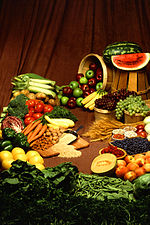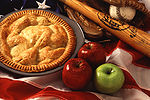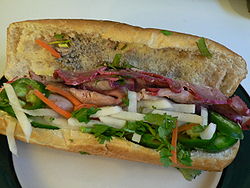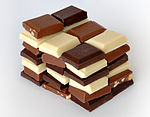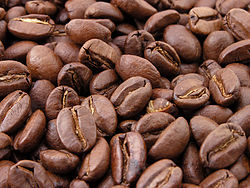
Portal:Food
|
edit
The Food Portal
Food is any substance that you can eat, usually composed primarily of carbohydrates, fats, minerals, water and/or proteins, that can be eaten or drunk and metabolized by almost all multicellular entities for nutrition or pleasure. Items considered food may be sourced from plants, animals or other categories such as fungus. Ranching, farming, fishing, hunting, foraging and other methods are ways to obtain food. Most traditions have a recognizable cuisine, a specific set of cooking traditions, preferences, and practices, the study of which is known as gastronomy. Many cultures have diversified their foods by means of preparation, cooking methods and manufacturing. This also includes a complex food trade which helps the cultures to economically survive by-way-of food, not just by consumption. Global cuisines can be defined as cuisine based upon global, continental, national, state or local regions; essentially as cuisines of the world. Many cultures study the dietary analysis of food habits. While humans are omnivores, religion and social constructs such as morality often affect which foods they will consume. Food safety is also a concern with foodborne illness claiming many lives each year. In English, the substance food is often used metaphorically or figuratively, as in food for thought.
edit
Selected article
edit
Did you know...
UsageThe template used to create these sub-pages is at {{ Selected DYK}}.
{{../box-header|Food 2 | Portal:Food/2 }} Portal:Food/2 Portal:Food/2 {{../box-footer|}} {{../box-header|Food 3 | Portal:Food/3 }} Portal:Food/3 Portal:Food/3 {{../box-footer|}} {{../box-header|Food 4 | Portal:Food/4 }} Portal:Food/4 Portal:Food/4 {{../box-footer|}} {{../box-header|Food 5 | Portal:Food/5 }} Portal:Food/5 Portal:Food/5 {{../box-footer|}} {{../box-header|Food 6 | Portal:Food/6 }} Portal:Food/6 Portal:Food/6 {{../box-footer|}} {{../box-header|Food 7 | Portal:Food/7 }} Portal:Food/7 Portal:Food/7 {{../box-footer|}} {{../box-header|Food 8 | Portal:Food/8 }} Portal:Food/8 Portal:Food/8 {{../box-footer|}} {{../box-header|Food 9 | Portal:Food/9 }} Portal:Food/9 Portal:Food/9 {{../box-footer|}} {{../box-header|Food 10 | Portal:Food/10 }} Portal:Food/10 Portal:Food/10 {{../box-footer|}} {{../box-header|Food 11 | Portal:Food/11 }} Portal:Food/11 Portal:Food/11 {{../box-footer|}} {{../box-header|Food 12 | Portal:Food/12 }} Portal:Food/12 Portal:Food/12 {{../box-footer|}} {{../box-header|Food 13 | Portal:Food/13 }} Portal:Food/13 Portal:Food/13 {{../box-footer|}} {{../box-header|Food 14 | Portal:Food/14 }} Portal:Food/14 Portal:Food/14 {{../box-footer|}} {{../box-header|Food 15 | Portal:Food/15 }} Portal:Food/15 Portal:Food/15 {{../box-footer|}} {{../box-header|Food 16 | Portal:Food/16 }} Portal:Food/16 Portal:Food/16 {{../box-footer|}} {{../box-header|Food 17 | Portal:Food/17 }} Portal:Food/17 Portal:Food/17 {{../box-footer|}} {{../box-header|Food 18 | Portal:Food/18 }} Portal:Food/18 Portal:Food/18 {{../box-footer|}} {{../box-header|Food 19 | Portal:Food/19 }} Portal:Food/19 Portal:Food/19 {{../box-footer|}} {{../box-header|Food 20 | Portal:Food/20 }} Portal:Food/20 Portal:Food/20 {{../box-footer|}} {{../box-header|Food 21 | Portal:Food/21 }} Portal:Food/21 Portal:Food/21 {{../box-footer|}} {{../box-header|Food 22 | Portal:Food/22 }} Portal:Food/22 Portal:Food/22 {{../box-footer|}} {{../box-header|Food 23 | Portal:Food/23 }} Portal:Food/23 Portal:Food/23 {{../box-footer|}} {{../box-header|Food 24 | Portal:Food/24 }} Portal:Food/24 Portal:Food/24 {{../box-footer|}} {{../box-header|Food 25 | Portal:Food/25 }} Portal:Food/25 Portal:Food/25 {{../box-footer|}} {{../box-header|Food 26 | Portal:Food/26 }} Portal:Food/26 Portal:Food/26 {{../box-footer|}} {{../box-header|Food 27 | Portal:Food/27 }} Portal:Food/27 Portal:Food/27 {{../box-footer|}} {{../box-header|Food 28 | Portal:Food/28 }} Portal:Food/28 Portal:Food/28 {{../box-footer|}} {{../box-header|Food 29 | Portal:Food/29 }} Portal:Food/29 Portal:Food/29 {{../box-footer|}} {{../box-header|Food 30 | Portal:Food/30 }} Portal:Food/30 Portal:Food/30 {{../box-footer|}} {{../box-header|Food 31 | Portal:Food/31 }} Portal:Food/31 Portal:Food/31 {{../box-footer|}} {{../box-header|Food 32 | Portal:Food/32 }} Portal:Food/32 Portal:Food/32 {{../box-footer|}} {{../box-header|Food 33 | Portal:Food/33 }} Portal:Food/33 Portal:Food/33 {{../box-footer|}} {{../box-header|Food 34 | Portal:Food/34 }} Portal:Food/34 Portal:Food/34 {{../box-footer|}} {{../box-header|Food 35 | Portal:Food/35 }} Portal:Food/35 Portal:Food/35 {{../box-footer|}} {{../box-header|Food 36 | Portal:Food/36 }} Portal:Food/36 Portal:Food/36 {{../box-footer|}} {{../box-header|Food 37 | Portal:Food/37 }} Portal:Food/37 Portal:Food/37 {{../box-footer|}} {{../box-header|Food 38 | Portal:Food/38 }} Portal:Food/38 Portal:Food/38 {{../box-footer|}} {{../box-header|Food 39 | Portal:Food/39 }} Portal:Food/39 Portal:Food/39 {{../box-footer|}} {{../box-header|Food 40 | Portal:Food/40 }} Portal:Food/40 Portal:Food/40 {{../box-footer|}} {{../box-header|Food 41 | Portal:Food/41 }} Portal:Food/41 Portal:Food/41 {{../box-footer|}} {{../box-header|Food 42 | Portal:Food/42 }} Portal:Food/42 Portal:Food/42 {{../box-footer|}} {{../box-header|Food 43 | Portal:Food/43 }} Portal:Food/43 Portal:Food/43 {{../box-footer|}} {{../box-header|Food 44 | Portal:Food/44 }} Portal:Food/44 Portal:Food/44 {{../box-footer|}} {{../box-header|Food 45 | Portal:Food/45 }} Portal:Food/45 Portal:Food/45 {{../box-footer|}} {{../box-header|Food 46 | Portal:Food/46 }} Portal:Food/46 Portal:Food/46 {{../box-footer|}} {{../box-header|Food 47 | Portal:Food/47 }} Portal:Food/47 Portal:Food/47 {{../box-footer|}} {{../box-header|Food 48 | Portal:Food/48 }} Portal:Food/48 Portal:Food/48 {{../box-footer|}} {{../box-header|Food 49 | Portal:Food/49 }} Portal:Food/49 Portal:Food/49 {{../box-footer|}} {{../box-header|Food 50 | Portal:Food/50 }} Portal:Food/50 Portal:Food/50 {{../box-footer|}}
edit
Selected recipe
edit
Selected ingredient
Pure, unsweetened chocolate contains primarily cocoa solids and cocoa butter in varying proportions. Much of the chocolate consumed today is in the form of sweet chocolate, combining chocolate with sugar. Milk chocolate is sweet chocolate that additionally contains milk powder or condensed milk. " White chocolate" contains cocoa butter, sugar, and milk but no cocoa solids (and thus does not qualify to be considered true chocolate). Chocolate contains alkaloids such as theobromine and phenethylamine, which have physiological effects on the body. It has been linked to serotonin levels in the brain. Scientists claim that chocolate, eaten in moderation, can lower blood pressure. Dark chocolate has recently been promoted for its health benefits, including a substantial amount of antioxidants that reduce the formation of free radicals, though the presence of theobromine renders it toxic to some animals, such as dogs and cats. Chocolate has become one of the most popular flavours in the world. Gifts of chocolate molded into different shapes have become traditional on certain holidays: chocolate bunnies and eggs are popular on Easter, chocolate coins on Hanukkah, Santa Claus and other holiday symbols on Christmas, and hearts on Valentine's Day. Chocolate is also used in cold and hot beverages, to produce chocolate milk and hot chocolate.
edit
Selected quote
edit
Selected person
edit
Selected picture
|
